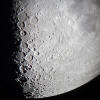 Now the full moon (left,
non-magnified) is the bane of backyard telescope astronomers. Its
bright light washes out all of the dim "fuzzies", such as galaxies and nebula,
as well as detail on planets. Unless, of course, you're studying the moon itself.
Since the moon always puts the same face towards us, what you see in one full
moon is what people have been seeing in full moons for thousands of years.
Now the full moon (left,
non-magnified) is the bane of backyard telescope astronomers. Its
bright light washes out all of the dim "fuzzies", such as galaxies and nebula,
as well as detail on planets. Unless, of course, you're studying the moon itself.
Since the moon always puts the same face towards us, what you see in one full
moon is what people have been seeing in full moons for thousands of years.
So, even this beast has its uses. Using your binoculars, and an inexpensive
moon-map (about $9 at Amazon), you can start identifying the craters and seas (mara).
You will, of course, want to find the Sea of Tranquility, the landing site of
Apollo 11.
 But
you can catch the moon between the rising crescent and the first quarter (halfway between new and full),
and use some binoculars on the "terminator" - where light meets shadow
- all of a
sudden the moon isn't boring at all. It comes alive as shadows in a landscape of mountains,
valleys and craters.
But
you can catch the moon between the rising crescent and the first quarter (halfway between new and full),
and use some binoculars on the "terminator" - where light meets shadow
- all of a
sudden the moon isn't boring at all. It comes alive as shadows in a landscape of mountains,
valleys and craters.
And, if you catch the moon around the crescent phase, or a couple days after,
you'll see something really special. The crescent part of the moon is lit, but
you can still see the rest of the disk, darkened. This is called "earthshine".
You're seeing this dark part of the disk because of light reflected off the the
Earth and back to the moon. It only lasts for a couple of nights, but you can
impress your friends with this fact alone.
For binoculars, if you don't already have a pair, you can probably find a
neighbor that does. A good choice is a decent set of 10X30 binoculars. The 10X means a
magnification of 10, and the 30 is the millimeter diameter of the objective
(front) lens.
If you are buying a pair of binoculars, don't get carried away. The most
important quality of a binocular (besides the optics) is you must be able to
hold them steady. This means avoid such things as 20X80, because you'll need a
tripod or some other steadying device for those things.
For backyard astronomy, the moon is a logical, rewarding, and (best of all)
inexpensive way to start.

